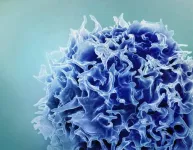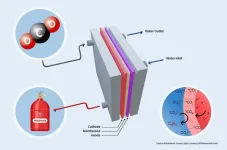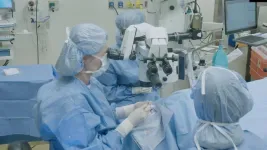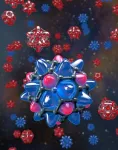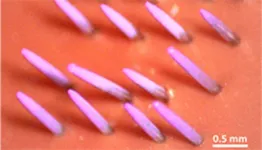(Press-News.org) LA JOLLA, CA—According to new research in the journal Immunity, T cells have a nuclear receptor doing something very odd—but very important—to help them fight pathogens and destroy cancer cells. This receptor, called retinoic acid receptor alpha (RARα), is known to control gene expression programs in the nucleus, but it also now appears to operate outside the cell nucleus to coordinate the early events triggered at the cell surface that lead to T cell activation.
Scientists wouldn’t normally expect to see a nuclear receptor such as RARα playing this role outside the cell nucleus. And yet the new findings suggest T cells cannot begin to fight disease without a form of RARα on the scene in the cytoplasm.
“Cytoplasmic retinoic acid receptors turn out to be central for a T cell to link sensing at the cell surface with downstream signaling cascades and gene expression programs that transform the T cell to become an active fighter,” says Professor Hilde Cheroutre, Ph.D., who led the new study at La Jolla Institute for Immunology (LJI) with LJI Assistant Professor Samuel Myers, Ph.D., LJI Professor Mitchell Kronenberg, Ph.D., and LJI Professor Emeritus Amnon Altman, Ph.D.
The study is also the result of a successful collaboration with scientists at the RIKEN Center for Integrative Medical Sciences in Japan and local teams at UC San Diego and the Salk Institute.
Helping T cells respond to danger
To understand this finding, it helps to picture the geography of a T cell. The cell nucleus (with its bundled-up DNA) sits in the middle of the cell. Other molecules and cellular structures called organelles float in the cytoplasm outside the nucleus surrounded by a membrane at the border of the cell (cell membrane).
Special molecules called T cell receptors (TCRs) sit on the cell membrane, where they receive messages from other cells. You can imagine TCRs as fire-spotters, the lookouts who scan for smoke from remote cabins in the wilderness. Just as fire-spotters need to alert officials to any smoke in the distance, TCRs need to quickly signal headquarters—the cell nucleus—if they detect a potential threat, such as a virus or cancer cell.
Sending that signal to the cell nucleus is critical for activating gene expression to transform the T cell to a fighter cell. But TCRs can’t just pick up a phone, so how do they alert the distant cell nucleus to trouble?
The signaling process is fascinating. Once the TCR is triggered, molecules called kinases (enzymes that add phosphates to proteins) work with adaptors that tell nearby proteins to “click” together and assemble a special molecular “activation complex.” This complex is called a TCR signalosome, and it comes together just inside the cell membrane. “The TCR signalosome is extremely important for mediating communication between the outside and the inside of a cell,” says Cheroutre.
And although the TCR signalosome has been studied by many people for many, many years, no one had ever detected RARα in this activation complex before.
“This new finding will change the way we think about TCR signals,” says Kronenberg.
Uncovering RARα’s role
RARα’s secret came to light thanks to the development of CRISPR techniques, advances in imaging and mass spectrometry—and years of hard work from the LJI team and collaborators.
RARα belongs to a large family of retinoic acid receptors that normally sit on control regions of target genes in the nucleus. These retinoic acid receptors recruit repressor and activator molecules that let them “switch off” or “switch on” expression of these target genes. This important job in the nucleus has earned retinoic acid receptors the title of “nuclear receptors.”
Several years ago, Cheroutre and her colleagues published research showing that retinoic acid (RA), which we get from vitamin A, triggers nuclear RARα and gene expression important for the differentiation of suppressive regulatory T cells that reduce the immune response.
For the new study, Cheroutre wanted to investigate how retinoic acid controls that suppressive T cell fate, so her laboratory started to look at retinoic acid receptors, such as RARα, more closely.
The researchers were intrigued to find that RARα actually comes in two variants, called isoforms. “These isoforms are encoded by the same gene, but they differ a little bit at one end. The consequences however are more significant and lock one form in the cytoplasm whereas the other form is confined to the nucleus” says Cheroutre.
Could these two isoforms play different roles in T cells? Looking closer, the researchers realized this RARα isoform did not respond to retinoic acid and didn’t even have the right equipment to function as a nuclear receptor.
“It didn’t have the tools that are important for nuclear receptors, namely the ability to interact with DNA and the ability to translocate from the cytoplasm to the nucleus,” says Cheroutre.
Using CRISPR gene editing techniques to modulate expression of the two isoforms, the researchers found that modulating the cytoplasmic isoform caused major problems for TCR signaling in the cytoplasm and impaired the communication with the control center in the nucleus.
RARα is in the right place at the right time
Once they knew where to look for this RARα isoform, the researchers tried to figure out what other proteins RARα interacted with. This work revealed interactions with the kinase ZAP70, a major component of the TCR signalosome.
Another important, early clue that RARα had a role outside of the nucleus came from proteomics work led by the Myers Lab. The researchers used techniques in mass spectrometry to detect a process called phosphorylation, which is when a molecule called a phosphoryl group is attached to proteins by an upstream kinase.
For T cells, phosphorylation spurs key proteins into action when a threat is near. “There are hundreds to thousands of dynamic phosphorylation events that occur during the first hour or so of T cell stimulation,” says Myers.
As Myers and his colleagues examined their data, they were surprised to spot a phosphorylation event related to RARα. In fact, phosphorylation of RARα began just three minutes into T cell activation. “Because this event was that early, our findings suggest that this phosphorylation of RARα is near the T cell receptor—and it has a burst in activity right after the TCR is stimulated,” says Myers.
This discovery added to the evidence that the cytoplasmic isoform of RARα is activated by the TCR instead of by RA like the nuclear RARα. Thus, this new form of RARα represents an essential component of the TCR/ZAP70 activation complex at the cell surface.
Cheroutre and her colleagues then shed light on another fascinating phenomenon in the cytoplasm. Scientists knew that RA, which is present in the blood and taken up by the T cells, is further transported to the nucleus by a molecule called cellular retinoic acid binding protein 2 (CRABP2). CRABP2 in the cytoplasm binds to RA and carries it into the cell nucleus where it activates nuclear RARα.
The researchers showed that without CRABP2, RA remains in the cytoplasm of the T cell and instead of activating cytoplasmic RARα, it interferes with TCR-activated RARα in the cytoplasm and blocks T cell activation. As a result, the T cell can no longer effectively fight infections or kill cancer cells. The good side of this phenomenon is that the interference of RA with the cytoplasmic RARα reduces the inflammatory response of the T cell. The researchers think this process may make an important target to fight autoimmune diseases and other inflammatory diseases.
Next steps for understanding TCR signaling
The new study emphasizes the importance of understanding not just a receptor’s location but its special talents and interacting partners.
“Retinoic acid receptors are really ‘complex formers’ and it all depends on who they recruit or reject. They have the unique capacity to engage molecules and release other molecules,” says Cheroutre. “Retinoic acid receptors are the ‘architects’ of complexes.”
The current study focused on T cells, but it may have implications for understanding signaling in many other cell types. For example, the Cheroutre Lab has gone on to show over-expression of this RARα isoform in the cytoplasm of cancer cells. What is extranuclear RARα doing there? What signals does it help relay?
“Understanding the role of this receptor has such major implications for studying protective immunity, anticancer therapies, autoimmune disease, and neurological diseases,” says Cheroutre.
The Myers Lab will spearhead the next steps in this research. Myers hopes to figure out exactly what RARα does in the TCR/ZAP70 signaling complex. “Does it modulate the signaling strength or duration? How does that change in signal propagate to gene expression and T cell activity?” he asks. His laboratory plans to use a “systems biochemistry” approach to further study the role of cytoplasmic and nuclear RARα in T cell activation and differentiation.
“The ultimate goal is to see if we can identify a new pathway, or set of pathways, that could be exploited to control autoimmune diseases and inflammation or enhance protective immunity to eradicate tumors or fight infections,” says Myers.
Additional authors of the study, “T Cell Activation is Spatially and Temporally Controlled by Extranuclear and Nuclear RARα,” are co-first authors Alexandre Larange, Ikuo Takazawa, Kiyokazu Kakugawa, and Nicolas Thiault; and co-authors Soomun Ngoi, Meagan E. Olive, Hitoshi Iwaya, Laetitia Seguin, Ildefonso Vicente-Suarez, Stephane Becart, Greet Verstichel, Ann Balancio, Amnon Altman, John T. Chang, Ichiro Taniuchi, and Bjorn Lillemeier.
This study was supported by the U.S. National Institutes of Health (grants U01 AI125957, P01 DK46763, and R01 AI106298), the Philippe Foundation, and a CCFA Fellowship (697275).
###
About La Jolla Institute
The La Jolla Institute for Immunology is dedicated to understanding the intricacies and power of the immune system so that we may apply that knowledge to promote human health and prevent a wide range of diseases. Since its founding in 1988 as an independent, nonprofit research organization, the Institute has made numerous advances leading toward its goal: life without disease. Visit lji.org for more information.
END
New LJI research has major implications for controlling T cell activity
How a supposed "nuclear" receptor makes TCR signaling possible
2023-08-18
ELSE PRESS RELEASES FROM THIS DATE:
Can soil microbes survive in a changing climate?
2023-08-18
Organisms across the globe are facing unprecedented levels of stress from climate change, habitat destruction, and many other human-driven changes to the environment. Predicting and mitigating the effects of this increasing stress on organisms, and the environmental services on which we depend, requires understanding why some species can exist in a wide range of environments while others exist in only a few habitats.
In the scientific world of ecology, researchers often try to sort organisms on our planet into two categories: specialists and generalists. Generalists can survive across a wide variety of environmental conditions and habitats, while specialists ...
Illinois Tech engineer spearheads research leading to groundbreaking green propane production method
2023-08-18
CHICAGO—August 18, 2023—A paper recently published in Nature Energy based on pioneering research done at Illinois Institute of Technology reveals a promising breakthrough in green energy: an electrolyzer device capable of converting carbon dioxide into propane in a manner that is both scalable and economically viable.
As the United States races toward its target of net-zero greenhouse gas emissions by 2050, innovative methods to reduce the significant carbon dioxide emissions from electric power and industrial sectors ...
Cell therapy that repairs cornea damage with patient’s own stem cells achieves positive phase I trial results
2023-08-18
BOSTON– A team led by researchers from Mass Eye and Ear, a member of Mass General Brigham, reports the results of a phase I trial of a revolutionary stem cell treatment called cultivated autologous limbal epithelial cell transplantation (CALEC), which was found to be safe and well-tolerated over the short term in four patients with significant chemical burns in one eye. According to the study published August 18 in Science Advances, the patients who were followed for 12 months experienced restored cornea surfaces — two were able to undergo a corneal transplant and two reported significant improvements in vision without additional treatment.
While ...
A new way to identify chiral molecules with light could vastly improve detection efficiency
2023-08-18
Chiral molecules are those that have two versions that are mirror images, like our right and left hands. These molecules have the same structure but different properties when they interact with other molecules, including those inside our bodies. This is important for example in drug molecules, where only the right- or left-handed version may have the desired effect.
Detecting and quantifying the chirality of matter however has been difficult. Current methods using a form of light that produces a (right- or left-twisting) helix ...
A new “spin” on ergodicity breaking
2023-08-18
In a recent Science paper, researchers led by JILA and NIST Fellow Jun Ye, along with collaborators JILA and NIST Fellow David Nesbitt, scientists from the University of Nevada, Reno, and Harvard University, observed novel ergodicity-breaking in C60, a highly symmetric molecule composed of 60 carbon atoms arranged on the vertices of a “soccer ball” pattern (with 20 hexagon faces and 12 pentagon faces). Their results revealed ergodicity breaking in the rotations of C60. Remarkably, they ...
UH leading multi-institutional program to provide research opportunities to postbaccalaureates
2023-08-18
With the juggling act of maintaining grades while also keeping a job, undergraduate students pursuing STEM degrees often graduate without any research experience, despite the benefits that research can have on their careers.
To provide more graduates from diverse backgrounds with research and mentoring experiences, Rebecca Zufall and Richard Meisel, associate professors of biology and biochemistry at the University of Houston’s College of Natural Sciences and Mathematics, are leading a multi-institutional program that will provide ...
Scientists develop efficient spray technique for bioactive materials
2023-08-18
Rutgers scientists have devised a highly accurate method for creating coatings of biologically active materials for a variety of medical products. Such a technique could pave the way for a new era of transdermal medication, including shot-free vaccinations, the researchers said.
Writing in Nature Communications, researchers described a new approach to electrospray deposition, an industrial spray-coating process. Essentially, Rutgers scientists developed a way to better control the target region within a spray zone as well as the electrical properties of microscopic ...
Public may overestimate pushback against controversial research findings
2023-08-18
Controversial research can put people on the defensive and may even lead to calls to censor findings that conflict with a particular ideological perspective. However, a pair of studies published in Psychological Science, by authors Cory J. Clark (University of Pennsylvania), Maja Graso (University of Groningen), Ilana Redstone (University of Illinois Urbana-Champaign), and Philip E. Tetlock (University of Pennsylvania), suggest a tendency to overestimate the risk that research findings will fuel public support for harmful actions.
Harmful actions related to research findings, according ...
UArizona Cancer Center study connects research scientists with the communities they serve
2023-08-18
A new study by University of Arizona Cancer Center researchers piloted a unique outreach strategy to foster dialogue between basic scientists and community members to demystify basic science research and facilitate culturally tailored approaches to address health disparities of vulnerable communities.
The paper, published in the journal Cancer Causes and Control, analyzes the processes, experiences and lessons learned during the establishment of the Research Outreach for Southern Arizona, or ROSA, program.
“Basic science research is critical ...
JMIR AI now included in the Directory Of Open Access Journals (DOAJ)
2023-08-18
(Toronto, August 18, 2023) JMIR Publications is happy to announce that JMIR AI has been accepted and indexed with the Directory of Open Access Journals (DOAJ). The DOAJ applies strict criteria to review and index Open Access journals, which include licensing and copyright criteria, quality control processes, journal website technical and usability setups, and editorial evaluation.
JMIR AI (JMIR AI ISSN 2817-1705, Editors-in-Chief: Khaled El Emam, PhD and Bradley Malin, PhD) is a new journal (launched in 2022) focusing on the applications of AI in health settings. This includes contemporary developments as well as historical examples, with an emphasis on sound ...
LAST 30 PRESS RELEASES:
Sleeping in on weekends may help boost teens’ mental health
Study: Teens use cellphones for an hour a day at school
After more than two years of war, Palestinian children are hungry, denied education and “like the living dead”
The untold story of life with Prader-Willi syndrome - according to the siblings who live it
How the parasite that ‘gave up sex’ found more hosts – and why its victory won’t last
When is it time to jump? The boiling frog problem of AI use in physics education
Twitter data reveals partisan divide in understanding why pollen season's getting worse
AI is quick but risky for updating old software
Revolutionizing biosecurity: new multi-omics framework to transform invasive species management
From ancient herb to modern medicine: new review unveils the multi-targeted healing potential of Borago officinalis
Building a global scientific community: Biological Diversity Journal announces dual recruitment of Editorial Board and Youth Editorial Board members
Microbes that break down antibiotics help protect ecosystems under drug pollution
Smart biochar that remembers pollutants offers a new way to clean water and recycle biomass
Rice genes matter more than domestication in shaping plant microbiomes
Ticking time bomb: Some farmers report as many as 70 tick encounters over a 6-month period
Turning garden and crop waste into plastics
Scientists discover ‘platypus galaxies’ in the early universe
Seeing thyroid cancer in a new light: when AI meets label-free imaging in the operating room
Neutrophil-to-lymphocyte ratio may aid risk stratification in depressive disorder
2026 Seismological Society of America Annual Meeting
AI-powered ECG analysis offers promising path for early detection of chronic obstructive pulmonary disease, says Mount Sinai researchers
GIMM uncovers flaws in lab-grown heart cells and paves the way for improved treatments
Cracking the evolutionary code of sleep
Medications could help the aging brain cope with surgery, memory impairment
Back pain linked to worse sleep years later in men over 65, according to study
CDC urges ‘shared decision-making’ on some childhood vaccines; many unclear about what that means
New research finds that an ‘equal treatment’ approach to economic opportunity advertising can backfire
Researchers create shape-shifting, self-navigating microparticles
Science army mobilizes to map US soil microbiome
Researchers develop new tools to turn grain crops into biosensors
[Press-News.org] New LJI research has major implications for controlling T cell activityHow a supposed "nuclear" receptor makes TCR signaling possible
